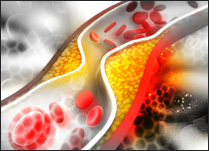September is National Cholesterol Educational Month: A Cholesterol Refresher
Most older adults know they should be concerned about their cholesterol. After all, an elevated cholesterol level is a major risk factor for heart disease. High cholesterol leads to a buildup of fatty deposits in the blood vessels. As these deposits grow, it becomes more and more difficult for blood to flow through the arteries, which results in a heart attack. If these fatty deposit break and form a clot, it could cause a stroke.
As these deposits grow, it becomes more and more difficult for blood to flow through the arteries, which results in a heart attack. If these fatty deposit break and form a clot, it could cause a stroke. September is National Cholesterol Educational Month. With that in mind, Visiting Angels Oshkosh wants older adults to know more about cholesterol, both the good and the bad. Read on for a brief cholesterol refresher and to learn how you can lower your cholesterol today.
What exactly is cholesterol?
Cholesterol is a waxy substance found in the blood. It is necessary in order to build healthy cells. It’s also used to make hormones and vitamin D, and helps support digestion. High levels of cholesterol can increase the risk for heart disease.
What is the difference between HDL and LDL?
There are two types of cholesterol, HDL, or high-density lipoprotein, and LDL, or low-density lipoprotein.
HDL is generally referred to as the “good cholesterol” because it helps rid the body of excess cholesterol. You want your HDL number to be high. Women should aim for more than 50 mg/dL and men, more than 40 mg/dL.
LDL is referred to as the “bad cholesterol” because it’s responsible for transporting cholesterol to the arteries. Regarding LDL, the lower the number the better. For those without heart disease, a level of 130 mg/dL is considered healthy. If you do have heart disease, this level drops to 100 mg/dL.
Where is cholesterol found?
Cholesterol is generated from the liver, but it’s also found in foods we eat, such as meat and dairy. Eggs have a bad rap over the years in regards to cholesterol. They are high in cholesterol, but can lead to increases in HDL. Other nutritious sources high-cholesterol foods include cheese, shellfish, organ meats, sardines, and full-fat yogurt.
There are a few foods you should avoid if you’re trying to lower your cholesterol. Deep fried foods, fast food, processed meats, and desserts are filled with high-cholesterol, unhealthy fats, and calories. Try to limit or remove these foods from your diet to lower your LDL.
What factors increase my risk of having a high cholesterol?
Older adults have a higher risk for developing high cholesterol, simply due to their age. As their body chemistry changes with age, their bodies are less effective in managing and removing lipoproteins (or fat and proteins that transport cholesterol). Other factors include a poor diet, obesity, lack of exercise, smoking, and diabetes. Genetics also play a role, but more often than not, high cholesterol is the result of an unhealthy lifestyle.
What are the symptoms of high cholesterol?
There are no symptoms for high cholesterol. A blood test is the only way to detect if you have high cholesterol. The American Heart Association recommends that adults over the age of 20 have their cholesterol checked every four to six years. Starting at age 40, health care providers should also calculate their patients’ 10-year risk of experiencing heart disease or stroke.
What can I do to lower my cholesterol?
Living a heart-healthy lifestyle can lower your cholesterol and even prevent it from reaching dangerous levels in the first place. If you are concerned about your cholesterol or have been diagnosed with high cholesterol, start by making changes to your diet. Aim to eat mostly fruits, vegetables, whole grains, and lean protein. Limit trans-fat and processed foods. If you are overweight, work toward losing weight by exercising and modifying your diet. Give up smoking and drink alcohol in moderation. These small changes can produce great results in your effort to lowering your cholesterol.
As you consider modifying your lifestyle to improve your health, perhaps it’s time that you bring home care into the picture. Visiting Angels Oshkosh provides a variety of home care services that help older adults live safely and independently in their own home. Our caregivers can help you plan nutritious meals and even help with the preparation. While they help with laundry, they can also escort you on a walk around your neighborhood so that you get the exercise you need. More than just a caregiver, our Angels strive to form a genuine companionship with their clients, helping to brighten their day. To learn more about our senior home care services, or to schedule your free consultation, please contact us by calling 920-312-7000.
